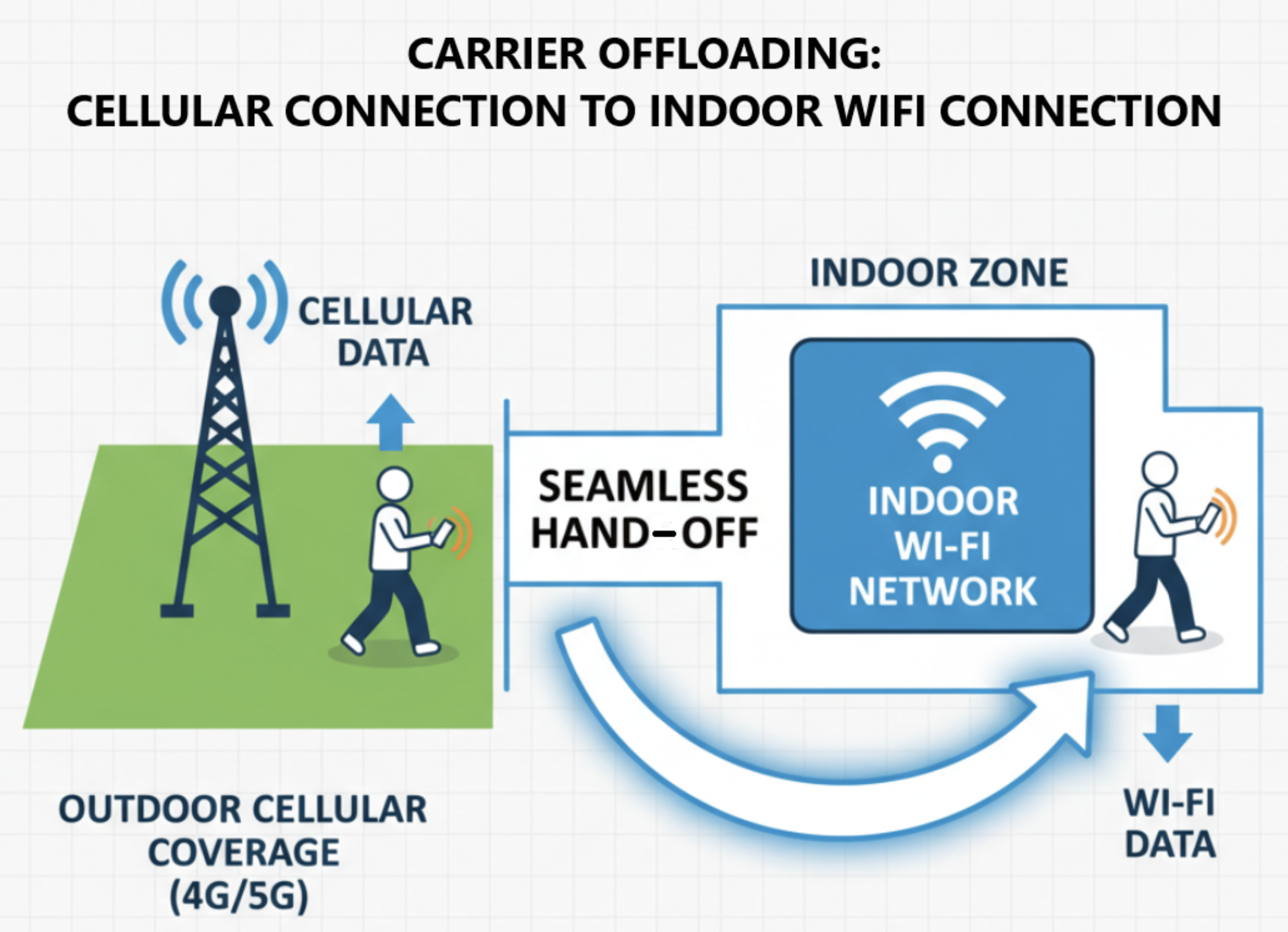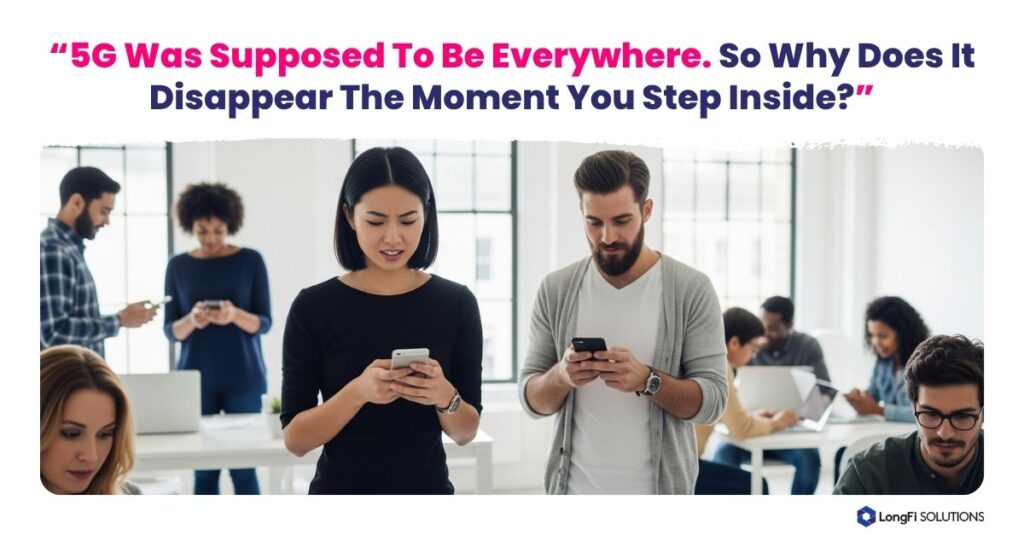Imagine this:
Sophia, an ambitious marketing executive, works from a trendy coworking space located inside a beautifully renovated historic building downtown. The interior features large windows made from energy-efficient glass designed to regulate temperature and reduce electricity consumption.
What Sophia didn’t expect was that this same glass acts as a shield against her coveted 5G signal.
She moves from one end of the building to another, holding her phone in different positions, awkwardly seeking a signal strong enough to download a vital client presentation. Yet, despite being in the heart of a 5G-covered city, she finds herself disconnected.
Welcome to the paradox of 5G.
While touted as revolutionary for its ultra-fast speeds, low latency, and incredible capacity, 5G’s real-world performance indoors has consistently fallen short of expectations. To understand why, we need to dive into the challenges this cutting-edge technology faces within our built environments.
📶 When Cell Signal Kills the Guest Experience
Today’s restaurants run on mobile.
QR code menus, contactless ordering, social sharing, and loyalty apps all rely on strong cellular connections. But the moment a guest steps inside, that signal can vanish — not because of bad service, but because of modern building materials.
According to Enea, 5G signals struggle 100x more than 4G to penetrate buildings. Materials like Low-E glass, steel, and concrete, standard in modern, energy-efficient construction, are blocking the very frequencies that power your guests’ devices.
If you’ve ever seen someone step outside just to load a menu or complete a mobile payment, you’re already feeling the impact.
Why 5G Struggles Indoors
The very characteristics that make 5G revolutionary are also those that cause its greatest challenges. At its most potent, 5G relies on high-frequency millimeter-wave (mmWave) technology to deliver astonishingly fast speeds. Unfortunately, mmWave signals are extremely sensitive to physical obstacles.
Concrete walls, energy-efficient glass, steel beams, even office cubicles; these everyday building materials act like impenetrable barriers, significantly reducing the strength and range of 5G signals. Unlike traditional 4G LTE frequencies, which can more readily penetrate solid structures, 5G signals degrade rapidly indoors, creating inconsistent coverage areas and frustrating experiences.
The glass and concrete effect is the daily reality for millions of users in modern, urban environments. The irony is profound: the very advancements in building efficiency and sustainability unintentionally hinder the seamless adoption of next-generation wireless technology.

Coverage Gaps and Capacity Constraints
Another critical challenge is the uneven distribution of indoor coverage. Building layouts, internal structures, and densely populated spaces compound the issue. Think about crowded locations, like airports, shopping malls, stadiums, and hospitals, where demand for fast, reliable connectivity is highest. These environments amplify the inherent limitations of 5G, creating significant gaps in indoor service delivery.
Imagine attending a sold-out concert or major sporting event. Everyone around you is livestreaming, posting on social media, or texting friends. Suddenly, your previously lightning-fast 5G slows dramatically or disappears altogether. It’s not just frustrating; it undermines trust in a technology expected to deliver superior performance in crowded environments.
Carrier Solutions: A Costly Endeavor
Telecommunications carriers have tried several solutions to tackle the indoor 5G challenge, from installing Distributed Antenna Systems (DAS) to deploying specialized indoor small cells. While effective, these methods often involve significant infrastructure costs, installation complexities, and long-term maintenance expenses.
For smaller businesses or historic properties, these solutions might be prohibitively expensive or challenging to implement, leaving many users without reliable indoor 5G coverage.
The Rise of WiFi Carrier Offloading
Interestingly, one emerging solution gaining traction is WiFi carrier offloading. Here, mobile carriers seamlessly transition a user’s connection from their outdoor cellular networks to indoor WiFi systems. Imagine it like a relay race: as you move indoors, your cellular data connection hands off smoothly to robust WiFi, preserving connectivity without interruption.
WiFi offloading doesn’t require new equipment installations or extensive renovations. It leverages existing WiFi infrastructure, making it cost-effective and accessible even for smaller businesses and venues.
Consider a bustling cafe downtown, frequently filled with remote workers and students. Instead of battling weak 5G signals, customers enjoy uninterrupted, high-quality connectivity because their devices automatically switch from cellular to the cafe’s WiFi. The cafe benefits as well, monetizing their WiFi infrastructure through carrier partnerships.
The Convergence of WiFi and Cellular is the Future
As 5G adoption grows, the importance of robust indoor connectivity becomes increasingly apparent. Users expect reliable coverage, not just outdoors but in every indoor space they frequent: offices, stores, public venues, and homes.
The path forward likely involves a hybrid approach, emphasizing robust WiFi offloading solutions and thoughtful architectural designs that balance aesthetics, sustainability, and connectivity.
Conquering the Indoor Challenge
The evolution of 5G presents an enormous opportunity alongside its significant challenges. Addressing indoor connectivity problems effectively will require collaboration among mobile carriers, business owners, infrastructure providers, and even building designers.
Innovative solutions like WiFi offloading offer seamless connectivity experiences that are cost-effective and practical. Ultimately, solving the indoor 5G puzzle means creating a world where your connection never falters, no matter where you step inside.
Next time you step into that downtown skyscraper or your favorite local cafe, imagine never having to second-guess your connectivity again. That’s the future 5G promises, and it’s within our grasp if we navigate these challenges thoughtfully.
#5G #DigitalWorkplace #InBuildingConnectivity #SmartBuildings #EnterpriseTech #WirelessNetworking

